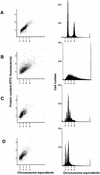Mutations in DnaA protein suppress the growth arrest of acidic phospholipid-deficient Escherichia coli cells
- PMID: 11230139
- PMCID: PMC145488
- DOI: 10.1093/emboj/20.5.1164
Mutations in DnaA protein suppress the growth arrest of acidic phospholipid-deficient Escherichia coli cells
Abstract
Cell growth arrests when the concentrations of anionic phospholipids drop below a critical level in Escherichia coli, with the insufficient amounts of acidic phospholipids adversely affecting the DnaA-dependent initiation of DNA replication at the chromosomal origin (oriC). Mutations have been introduced into the carboxyl region of DnaA, including the portion identified as essential for productive in vitro DnaA-acidic phospholipid interactions. Expression of DnaA proteins possessing certain small deletions or substituted amino acids restored growth to cells deficient in acidic phospholipids, whereas expression of wild-type DnaA did not. The mutations include substitutions and deletions in the phospholipid-interacting domain as well as some small deletions in the DNA-binding domain of DnaA. Marker frequency analysis indicated that initiation of replication occurs at or near oriC in acidic phospholipid- deficient cells rescued by the expression of DnaA having a point mutation in the membrane-binding domain, DnaA(L366K). Flow cytometry revealed that expression in wild-type cells of plasmid-borne DnaA(L366K) and DnaA(Delta363-367) reduced the frequency with which replication was initiated and disturbed the synchrony of initiations.
Figures

Similar articles
-
The reactivation of DnaA(L366K) requires less acidic phospholipids supporting their role in the initiation of chromosome replication in Escherichia coli.FEBS Lett. 2007 Sep 18;581(23):4439-42. doi: 10.1016/j.febslet.2007.08.019. Epub 2007 Aug 17. FEBS Lett. 2007. PMID: 17719583
-
Restoration of growth to acidic phospholipid-deficient cells by DnaA(L366K) is independent of its capacity for nucleotide binding and exchange and requires DnaA.J Biol Chem. 2005 Mar 18;280(11):9796-801. doi: 10.1074/jbc.M413923200. Epub 2005 Jan 10. J Biol Chem. 2005. PMID: 15642730
-
DnaA Protein of Escherichia coli: oligomerization at the E. coli chromosomal origin is required for initiation and involves specific N-terminal amino acids.Mol Microbiol. 2003 Aug;49(3):849-58. doi: 10.1046/j.1365-2958.2003.03603.x. Mol Microbiol. 2003. PMID: 12864864
-
Crosstalk between DnaA protein, the initiator of Escherichia coli chromosomal replication, and acidic phospholipids present in bacterial membranes.Int J Mol Sci. 2013 Apr 17;14(4):8517-37. doi: 10.3390/ijms14048517. Int J Mol Sci. 2013. PMID: 23595001 Free PMC article. Review.
-
Escherichia coli DnaA protein--phospholipid interactions: in vitro and in vivo.Biochimie. 2001 Jan;83(1):19-23. doi: 10.1016/s0300-9084(00)01224-4. Biochimie. 2001. PMID: 11254970 Review.
Cited by
-
Envelope disorder of Escherichia coli cells lacking phosphatidylglycerol.J Bacteriol. 2002 Oct;184(19):5418-25. doi: 10.1128/JB.184.19.5418-5425.2002. J Bacteriol. 2002. PMID: 12218030 Free PMC article.
-
Biochemical analysis of DnaA protein with mutations in both Arg328 and Lys372.Biochem J. 2002 Mar 1;362(Pt 2):453-8. doi: 10.1042/0264-6021:3620453. Biochem J. 2002. PMID: 11853554 Free PMC article.
-
Initiation of DNA Replication.EcoSal Plus. 2010 Sep;4(1):10.1128/ecosalplus.4.4.1. doi: 10.1128/ecosalplus.4.4.1. EcoSal Plus. 2010. PMID: 26443786 Free PMC article.
-
Depletion of acidic phospholipids influences chromosomal replication in Escherichia coli.Microbiologyopen. 2012 Dec;1(4):450-66. doi: 10.1002/mbo3.46. Epub 2012 Nov 16. Microbiologyopen. 2012. PMID: 23233230 Free PMC article.
-
A novel membrane stress response that blocks chromosomal replication by targeting the DnaA initiator via the ClpP protease.J Bacteriol. 2025 Jul 24;207(7):e0015125. doi: 10.1128/jb.00151-25. Epub 2025 Jun 24. J Bacteriol. 2025. PMID: 40552815 Free PMC article.
References
-
- Boye E. and Løbner-Olesen,A. (1991) Bacterial growth control studied by flow cytometry. Res. Microbiol., 142, 131–135. - PubMed
-
- Crooke E., Castuma,C.E. and Kornberg,A. (1992) The chromosome origin of E.coli stabilizes DnaA protein during rejuvenation by phospholipids. J. Biol. Chem., 267, 16779–16782. - PubMed
-
- Crooke E., Thresher,R., Hwang,D.S., Griffith,J. and Kornberg,A. (1993) Replicatively active complexes of DnaA protein and the Escherichia coli chromosomal origin observed in the electron microscope. J. Mol. Biol., 233, 16–24. - PubMed
-
- Fuller R., Funnell,B. and Kornberg,A. (1984) The DnaA protein complex with the E.coli chromosomal replication origin (oriC) and other DNA sites. Cell, 38, 889–900. - PubMed
Publication types
MeSH terms
Substances
Grants and funding
LinkOut - more resources
Full Text Sources

